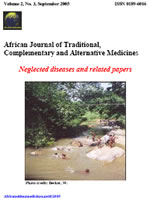
|
African Journal of Traditional, Complementary and Alternative Medicines
African Ethnomedicines Network
ISSN: 0189-6016
Vol. 14, No. 3, 2017, pp. 280-286
|
 Bioline Code: tc17104
Bioline Code: tc17104
Full paper language: English
Document type: Research Article
Document available free of charge
|
|
|
African Journal of Traditional, Complementary and Alternative Medicines, Vol. 14, No. 3, 2017, pp. 280-286
| en |
EVALUATION OF CRUDE FLAXSEED ( Linum usitatissimum  L.) OIL IN BURN WOUND HEALING IN NEW ZEALAND RABBITS L.) OIL IN BURN WOUND HEALING IN NEW ZEALAND RABBITS
Beroual, Katiba; Agabou, Amir; Abdeldjelil, Mohamed-Cherif; Boutaghane, Naima; Haouam, Saïd & Hamdi-Pacha, Youcef
Abstract
Background: Burns are among the most prevalent injuries in humans with high cost in health care and heavy
prolonged or permanent physical, psychological and social consequences. Commercial antimicrobial creams and
dressing agents are unsuccessful in healing deep burn wounds.
Materials and Methods: A study was conducted to assess the impact of crude linseed oil (LSO) topical application on
burn wounds healing in rabbits in comparison with untreated wounds (NAT) and those treated with Vaseline gel
(VAG) and Cicatryl-Bio ointment (CBO). By the 28th day post burning, skin biopsies were analyzed for histological
and cytological lesions. The presence of various bioactive phytochemical groups in linseed was also screened.
Results: Phytochemical screening has resulted in high concentrations of flavonoids and terpenoids, low amounts of
catechic tannins and total absence of alkaloids and saponosides. All along the trial, the rate of wounds contraction was
found to be significantly higher in burns treated with LSO which had also a significant shorter healing period (26±5.89
days) as compared to the other treatments. LSO healed wounds included less inflammatory cells, complete epithelium
regeneration with a reduced thickness of the new formed dermis, discreet fibrosis, enhanced neo-vascularization,
increased number of collagen fibers, fibroblasts and many myofibroblasts. Additionally, no adverse effects of LSO on
cicatrization process were recorded.
Conclusion: These findings prove the safety and efficaciousness of linseed oil topical application in the therapy of
burn wounds.
Keywords
Linseed oil; phytochemical screening; topical application; burn wounds; healing; rabbits
|
| |
© Copyright 2017 - African Journal of Traditional, Complementary and Alternative Medicines
Alternative site location: http://journals.sfu.ca/africanem/index.php/ajtcam
|
|
